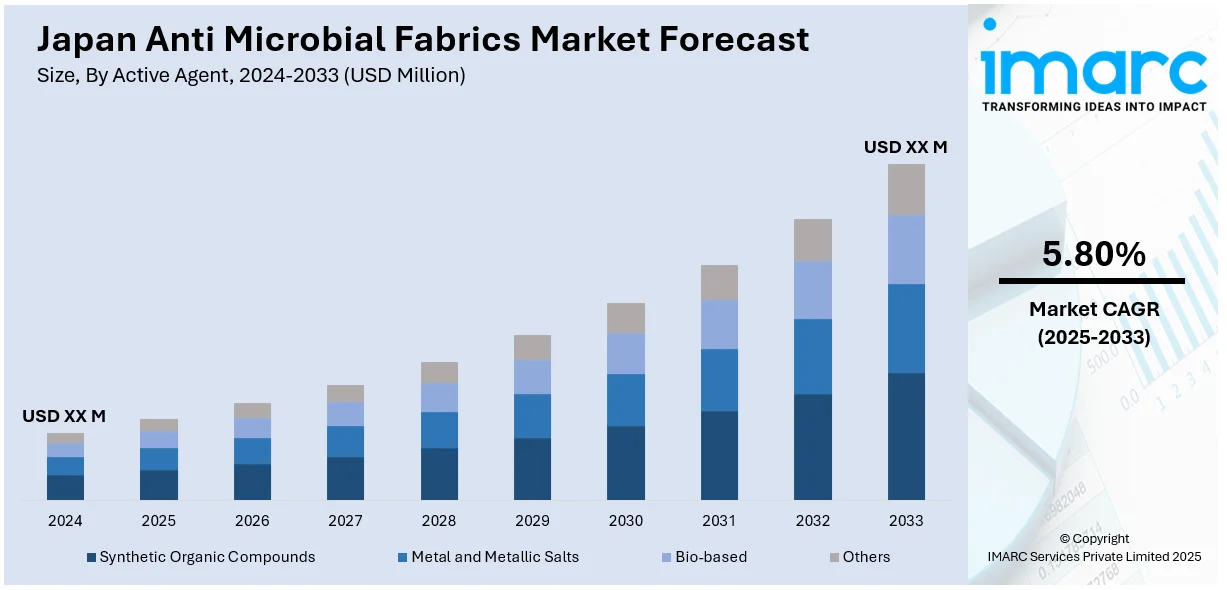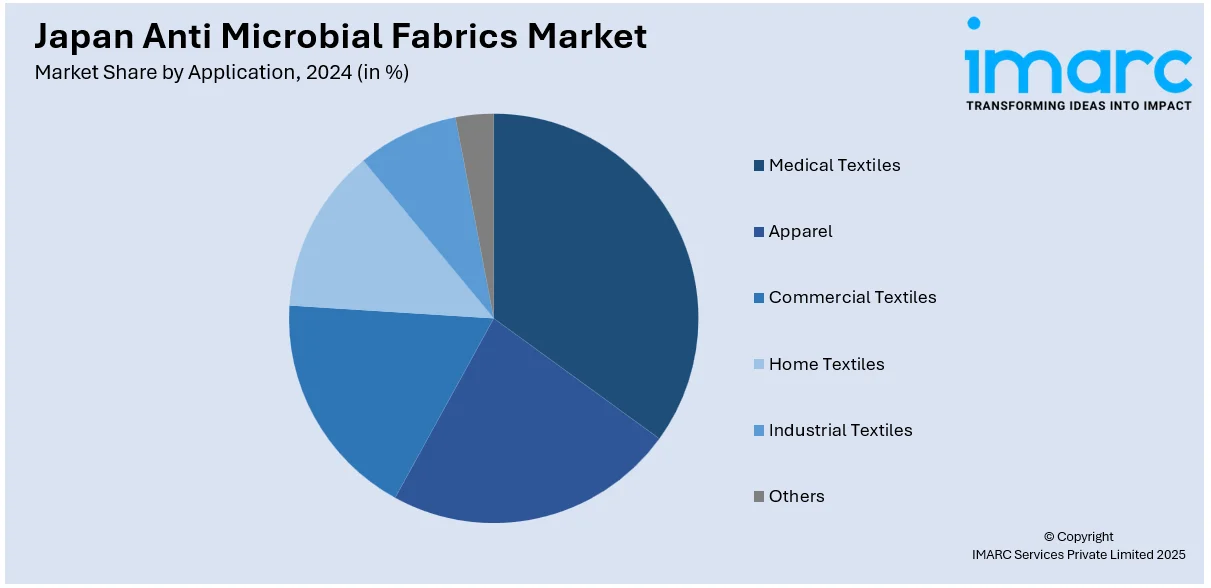
Japan Anti Microbial Fabrics Market Size, Share, Trends and Forecast by Active Agent, Application, and Region, 2025-2033
Japan Anti Microbial Fabrics Market Overview:
The Japan anti microbial fabrics market size is projected to exhibit a growth rate (CAGR) of 5.80% during 2025-2033. The growth of market is driven by several key factors, including an aging population, dependence on e-commerce, and the increasing demand for smart textiles. Elderly individuals’ heightened susceptibility to infections, coupled with the growing prominence of digital retail platforms, is catalyzing the demand for innovative, hygienic fabrics. These developments, alongside the shift toward advanced textile technologies, are contributing to expansion of the Japan anti microbial fabrics market share.
|
Report Attribute
|
Key Statistics
|
|---|---|
|
Base Year
|
2024 |
|
Forecast Years
|
2025-2033
|
|
Historical Years
|
2019-2024
|
| Market Growth Rate 2025-2033 | 5.80% |
Japan Anti Microbial Fabrics Market Trends:
Growth of Elderly Population
Japan's elderly demographic is significantly contributing to the growth of the anti microbial fabrics market. As per government statistics released in 2024, the nation's senior demographic has hit a historic 36.25 million, with those aged 65 and older making up 29.3% of the overall population, which was the largest percentage worldwide among countries with more than 100,000 residents. This demographic change is catalyzing the demand for products that emphasize hygiene and health, especially in eldercare and healthcare environments. Elderly individuals have a higher susceptibility to infections because of compromised immune systems, which is driving the demand for anti microbial fabrics for minimizing the risk of bacterial and fungal proliferation. These materials are progressively utilized in medical bedding, gowns, and common household care items, such as pillows and blankets. With the growing senior population in Japan, the need for specialized textiles is increasing considerably, thereby encouraging the adoption and use of anti microbial fabric solutions in various industries.

Integration with E-commerce and Online Retail Platforms
The growing number of e-commerce and online retail platforms is driving the need for anti microbial fabrics in Japan. With the rise of digital shopping, the availability and visibility of health-oriented products, such as anti microbial fabrics, are significantly enhanced. Internet platforms enable users to investigate numerous choices, ranging from clothing to home décor, offering comprehensive product details, comparisons, and user feedback that assist in making informed buying decisions. This transition is particularly significant due to the swift expansion of Japan’s e-commerce sector, which hit USD 258.0 billion in 2024 and is anticipated to surge to USD 692.8 billion by 2033, with a CAGR of 11.02% as reported by IMARC Group. This increase in online shopping offers brands a robust platform to highlight the hygiene advantages of anti microbial materials, appealing to wider audiences and promoting product uptake. The blend of convenience, focused marketing, and rising health consciousness continues to support the market growth throughout Japan.
Increasing Popularity of Smart Textiles
The rising use of smart textiles, which include fabrics that incorporate cutting-edge technology, is substantially contributing to the Japan anti microbial fabrics market growth. These high-performance fabrics provide multi-faceted advantages, including self-cleaning properties, temperature control, moisture management, and antibacterial protection, catering to the growing need for inventive, sanitary, and easy-care options. Smart textiles with anti microbial properties assist in decreasing bacterial accumulation, limiting odors, and enhancing product lifespan, which is particularly attractive to health-conscious and tech-savvy shoppers. As industries look for next-generation materials for wearables, healthcare, and sportswear, anti microbial smart fabrics are becoming a key focus. The smart textiles market in Japan attained USD 250.9 million in 2024 and is anticipated to expand swiftly, reaching USD 1,547.0 million by 2033, with a CAGR of 20.5%, as reported by IMARC Group. This remarkable growth indicates that smart textiles featuring anti microbial properties are not only becoming more popular but are also transforming the future of Japan’s textile sector.
Japan Anti Microbial Fabrics Market Segmentation:
IMARC Group provides an analysis of the key trends in each segment of the market, along with forecasts at the country and regional levels for 2025-2033. Our report has categorized the market based on active agent and application.
Active Agent Insights:
- Synthetic Organic Compounds
- Metal and Metallic Salts
- Bio-based
- Others
The report has provided a detailed breakup and analysis of the market based on the active agent. This includes synthetic organic compounds, metal and metallic salts, bio-based, and others.
Application Insights:

- Medical Textiles
- Apparel
- Commercial Textiles
- Home Textiles
- Industrial Textiles
- Others
A detailed breakup and analysis of the market based on the application have also been provided in the report. This includes medical textiles, apparel, commercial textiles, home textiles, industrial textiles, and others.
Regional Insights:
- Kanto Region
- Kansai/Kinki Region
- Central/ Chubu Region
- Kyushu-Okinawa Region
- Tohoku Region
- Chugoku Region
- Hokkaido Region
- Shikoku Region
The report has also provided a comprehensive analysis of all the major regional markets, which include Kanto Region, Kansai/Kinki Region, Central/ Chubu Region, Kyushu-Okinawa Region, Tohoku Region, Chugoku Region, Hokkaido Region, and Shikoku Region.
Competitive Landscape:
The market research report has also provided a comprehensive analysis of the competitive landscape. Competitive analysis such as market structure, key player positioning, top winning strategies, competitive dashboard, and company evaluation quadrant has been covered in the report. Also, detailed profiles of all major companies have been provided.
Japan Anti Microbial Fabrics Market Report Coverage:
| Report Features | Details |
|---|---|
| Base Year of the Analysis | 2024 |
| Historical Period | 2019-2024 |
| Forecast Period | 2025-2033 |
| Units | Million USD |
| Scope of the Report |
Exploration of Historical Trends and Market Outlook, Industry Catalysts and Challenges, Segment-Wise Historical and Future Market Assessment:
|
| Active Agents Covered | Synthetic Organic Compounds, Metal and Metallic Salts, Bio-based, Others |
| Applications Covered | Medical Textiles, Apparel, Commercial Textiles, Home Textiles, Industrial Textiles, Others |
| Regions Covered | Kanto Region, Kansai/Kinki Region, Central/ Chubu Region, Kyushu-Okinawa Region, Tohoku Region, Chugoku Region, Hokkaido Region, Shikoku Region |
| Customization Scope | 10% Free Customization |
| Post-Sale Analyst Support | 10-12 Weeks |
| Delivery Format | PDF and Excel through Email (We can also provide the editable version of the report in PPT/Word format on special request) |
Key Questions Answered in This Report:
- How has the Japan anti microbial fabrics market performed so far and how will it perform in the coming years?
- What is the breakup of the Japan anti microbial fabrics market on the basis of active agent?
- What is the breakup of the Japan anti microbial fabrics market on the basis of application?
- What is the breakup of the Japan anti microbial fabrics market on the basis of region?
- What are the various stages in the value chain of the Japan anti microbial fabrics market?
- What are the key driving factors and challenges in the Japan anti microbial fabrics market?
- What is the structure of the Japan anti microbial fabrics market and who are the key players?
- What is the degree of competition in the Japan anti microbial fabrics market?
Key Benefits for Stakeholders:
- IMARC’s industry report offers a comprehensive quantitative analysis of various market segments, historical and current market trends, market forecasts, and dynamics of the Japan anti microbial fabrics market from 2019-2033.
- The research report provides the latest information on the market drivers, challenges, and opportunities in the Japan anti microbial fabrics market.
- Porter's five forces analysis assist stakeholders in assessing the impact of new entrants, competitive rivalry, supplier power, buyer power, and the threat of substitution. It helps stakeholders to analyze the level of competition within the Japan anti microbial fabrics industry and its attractiveness.
- Competitive landscape allows stakeholders to understand their competitive environment and provides an insight into the current positions of key players in the market.
Need more help?
- Speak to our experienced analysts for insights on the current market scenarios.
- Include additional segments and countries to customize the report as per your requirement.
- Gain an unparalleled competitive advantage in your domain by understanding how to utilize the report and positively impacting your operations and revenue.
- For further assistance, please connect with our analysts.
 Request Customization
Request Customization
 Speak to an Analyst
Speak to an Analyst
 Request Brochure
Request Brochure
 Inquire Before Buying
Inquire Before Buying




.webp)




.webp)












